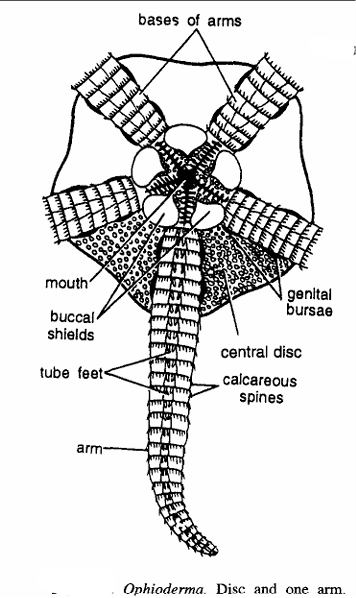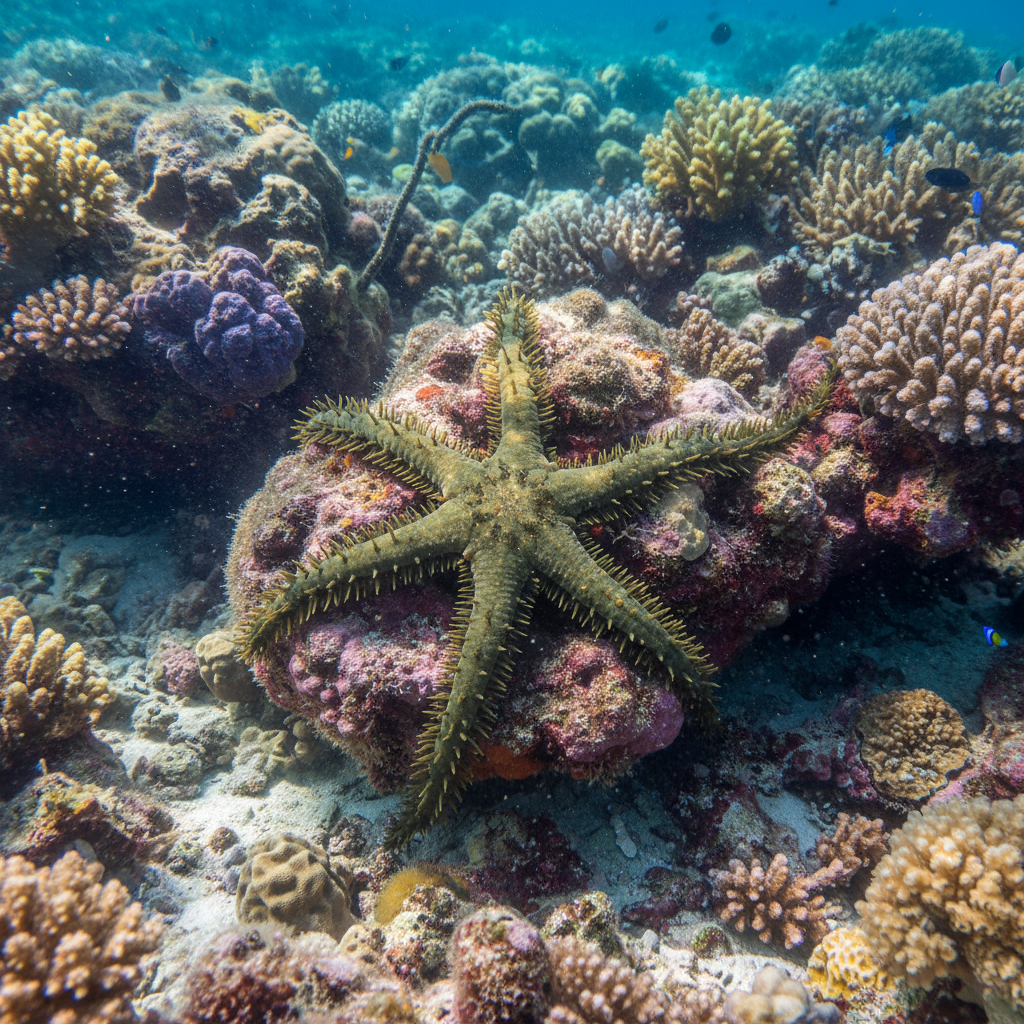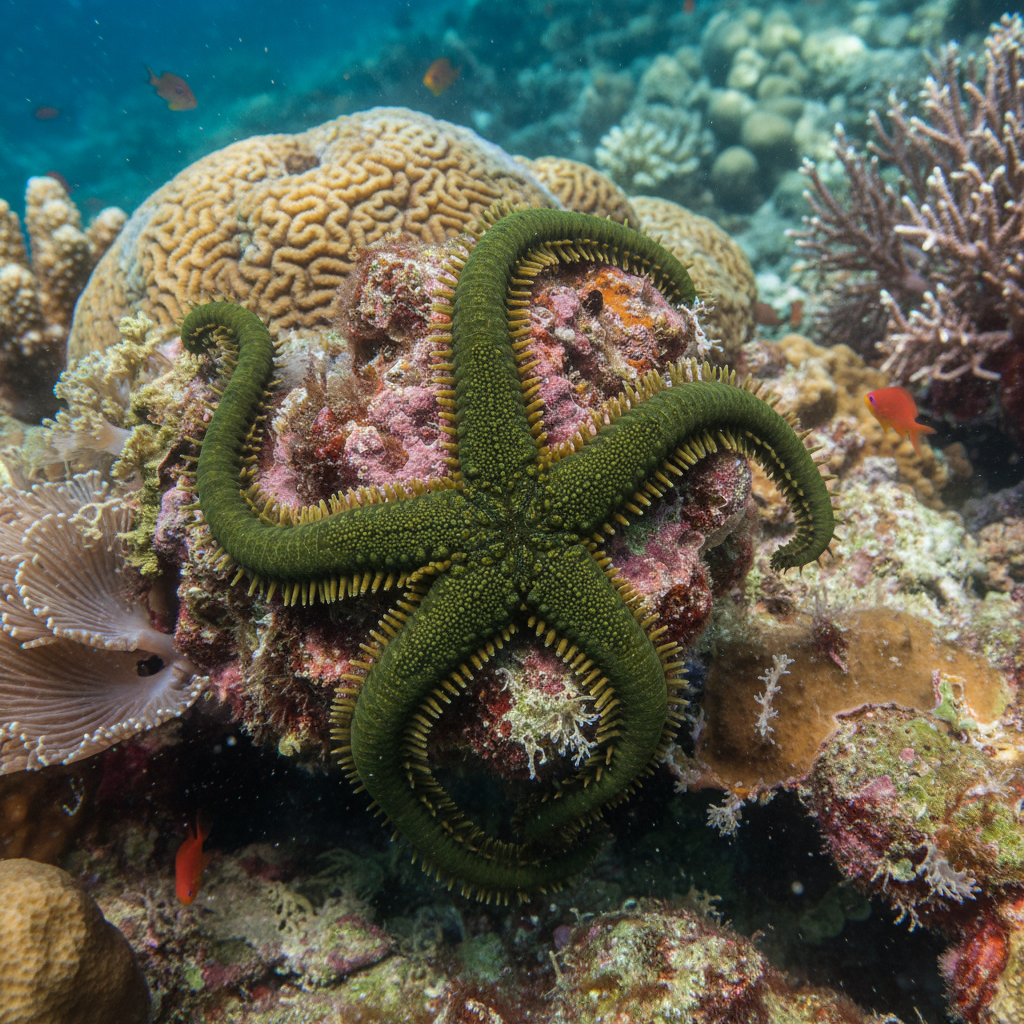Ophioderma: Morphology, Classification, Habitat, and Ecological Role of Brittle Stars
Ophioderma is a genus of brittle stars belonging to the family Ophiodermatidae in the class Ophiuroidea. Brittle stars, also known as serpent stars due to their snake-like flexible arms, are closely related to starfish but differ by having a distinct central disc and more slender, highly flexible arms. Species of Ophioderma are found mostly in shallow marine waters, often under rocks or hiding within coral reefs. These animals are known for their quick, serpentine movements and ability to regenerate lost arms.
Classification of Ophioderma
| Taxonomic Rank | Name | Characteristics |
|---|---|---|
| Kingdom | Animalia | Multicellular eukaryotes |
| Phylum | Echinodermata | Marine animals with radial symmetry and calcite skeleton |
| Class | Ophiuroidea | Brittle stars with slender, flexible arms |
| Order | Ophiacanthida | Brittle stars with spiny arms and scales |
| Family | Ophiodermatidae | Brittle stars with segmented vertebral ossicles |
| Genus | Ophioderma | Brittle stars with pentagonal discs and whip-like arms |

Habit and Habitat
Species thrive in shallow, warm waters, often in coral reef environments or rocky seabeds where they can hide during the day. They emerge mainly at night to feed and avoid predation by retreating into crevices or under substrates.
General Characteristics
- Commonly called as brittle star.
- Body consists of a small pentagonal disc set by closely set granules.
- Oral papillae numerous and arranged in a continuous series.
- Body is differentiated into oral and aboral surfaces with distinct central disc and five surpentine arms.
- Arms are covered by arm shields or calcareous ossicles and small spines.
- The oral surface has star-shaped mouth fringed with oral papillae.
- Skin covers the disc which is composed calcareous plates in the disc and typically of articulating ossicles in the arms.
- Internal structures are restricted to central disc only. Anus and pedicellariae absent. Madreporite is oral.
- The ambulacral grooves are usually covered. Tube feet lack suckers.
- Most important individual characteristic feature of the genus is the presence of two slits in each bursa, one situated orally and the other peripherally.
- Larva is Ophiopluteus.
- Body Structure: Distinct pentagonal central disc with five long, slender, whip-like arms.
- Arm Features: Arms are jointed and flexible, covered with spines and scales; capable of rapid movements.
- Surface Texture: The disc and arms bear large radial shields and smaller overlapping scales.
- Mouth: Located on the underside of the central disc surrounded by toothed jaws.
- Tube Feet: Small and mainly sensory rather than used for locomotion.

Special Features
- Movement: Unlike starfish that move slowly, Ophioderma moves by coordinated wriggling or snake-like motions of the arms.
- Regeneration: Can regenerate lost arms efficiently to evade predators.
- Reproduction: Separate sexes with external fertilization; larvae are planktonic before settling as juveniles.
- Feeding Behavior: Mainly scavengers or detritivores, feeding on organic debris and small invertebrates.
- Defense: Ability to autotomize arms when threatened.
Identification
- Pentagonal central disc with clear radial and adradial shields.
- Whip-like flexible arms with spiny projections.
- Presence of genital bursae between arm bases.
- Often greenish or olive coloration but varies.
Life Cycle and Reproduction
Ophioderma brittle stars reproduce sexually via broadcast spawning, releasing eggs and sperm into the water. Larvae undergo planktonic development before settling and metamorphosing into the adult form. Asexual reproduction has also been observed in some related species through disc fission.

Ecological Role and Importance
Ophioderma plays an essential role in benthic ecosystems as scavengers contributing to nutrient cycling and detritus breakdown. Their presence indicates a healthy reef ecosystem. Their rapid movement and regeneration abilities provide valuable insights into echinoderm physiology and developmental biology.
References
- https://en.wikipedia.org/wiki/Brittle_star
- https://en.wikipedia.org/wiki/Ophioderma_(echinoderm)
- https://animalfact.com/brittle-star/
- https://sealifebase.se/summary/Ophioderma-squamosissimum.html
- https://pmc.ncbi.nlm.nih.gov/articles/PMC3689063/
- https://www.britannica.com/animal/brittle-star
- https://www.biologydiscussion.com/zoology/practicals/structure-of-brittle-star-ophioderma-with-diagram-zoology/60709
- https://www.atlantisgozo.com/marine-life-malta/ophioderma-longicauda-smooth-brittle-star/
- https://zookeys.pensoft.net/article/3595/
- http://indobis.in/wp-content/uploads/2022/08/Brittle-stars-final.pdf

